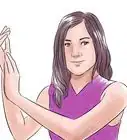This article was co-authored by Traci Halvorson. Traci Halvorson is a Modeling Agent, Former Model, and the Owner of Halvorson Model Management (HMM) in San Jose, California. HMM is a full-service, licensed talent agency representing over 300 professional models and actors. With over 25 years of experience in the modeling industry, Traci specializes in scouting, managing, advising, and launching modeling careers in the Bay Area. Traci holds a BA in Public Relations & Business Management from San Jose State University and also specializes in Marketing, Image consulting, and is a certified Life-Career Coach.
This article has been viewed 137,644 times.
Getting into modeling is tough, but it is impossible without great portfolio pictures. Whether you're the photographer or the model, getting good photos is not hard -- all you need is decent lighting, a calm demeanor, and a willingness to ham it up a bit for the camera.
Steps
Photographing for a Model
-
1Shoot outdoors unless you have a near-professionally lit indoor space. You will save yourself 100's of headaches if you just shoot outside, aiming for the 1.5 hours after sunrise or before sunset. This is known as the "golden hour," when sunlight naturally diffuses through the atmosphere for soft, appealing shadows and well-rounded lighting.
- Overcast days are great shooting days, as they provide naturally soft lighting as well. You should still avoid shooting from 11:00 AM - 1:00 PM, when the sun is directly overhead, however.
- If you do have to shoot inside, turn on every light and open every window. The more light, the better.[1]
-
2Choose a bland, basic background. A great scene or setting in the back simply distracts from your model. A modeling agency doesn't care about the setting of the photo, they care who is in it. A plainly colored wall that the subjects "pops" from is your only concern.
- Don't match the model with the background. A black man shouldn't be on a dark brown background, and a woman in a bright dress shouldn't be flush against a yellow wall. You want contrast.
- When taking photos, leave the background out of focus, making the model pop out even more.
Advertisement -
3Ensure your model is evenly lit, without any dramatic shadows. While a hard shadow looks great in a regular photo, the fact is modeling agencies need to see as much of the model's body as possible.While you want some shadows for definition, you need to aim for clarity above all.
- Pay careful attention to the face, particularly the eye sockets, for dark or distracting shadows. A reflective bounce or weak light on the face can usually eliminate any issues.
-
4Do your best to make the model comfortable, happy, and willing to play. Taking modeling photos is a creative endeavor, and it should be a lot of fun. This isn't just to have a good time -- a happy model is a relaxed one, and relaxed models always look better on camera. The best way to do this is talk -- find out what kind of shots they want, their general personality, and the type of modeling they're interested in.
- Don't feel bad about "taking control." People, especially on camera, want to be told what looks good. So move the model around, make them smile, and give direction.[2]
-
5Make sure you cover the three "essential" photos before you start getting creative. The following are your can't-miss shots: the three images you must have good copies of in order to get the bare minimum. Luckily, they are simple, easy shots to set up, and you've seen countless examples of them in ads and magazines.
- Full Body: Simple and easy, you capture the model from head to toe.[3] Good posture, is key, as is shooting slightly from below the subject -- it makes them seem bigger and more manly.
- Half-length: From the mid-thigh up. Hands can be up, in pockets, or out. Again, shoot from below for the best results.
- Waist Up: Particularly necessary for shirtless models, this cuts right at the hip. If shirtless, make sure that no fabric is showing. Again, a lower angle makes everyone look hotter.[4]
-
6Always retouch photos before sending them back to the model. Even if you're not particularly practiced as a photo editor, you should still take a little time to work on the photos before sending them. It doesn't matter what program you're using, you should, at least, take a look at:
- Crop: Crop the image so that model takes up most of the frame, and isn't cut off in any way. You want the shot to be pretty tight like it was a full-page magazine ad
- Brightness & Contrast: Make sure the darkest parts of the picture (there shouldn't be many) are a nice deep black, and there are no nasty, bright white glares.
- Hue Saturation: This changes some basic color settings. It can be useful for balancing images. For example, if there is a distracting red glow coming off a red dress, you can lower the saturation of the "red" slider to faintly tone the reds in the image down. You can also boost overall saturation to add some more color "pop" into the picture.
- Clarity: Usually offered on only higher-end programs, this catch-all setting for sharpness and image quality is useful when bumped up 8-12. Don't go above 20.
-
7Send the model the retouched shots for approval. To go the extra mile, send them copies of each shot in black and white as well (which may require a retouch of Brightness & Contrast), so that they have the option to use either. Ask them if there were any other shots they liked, or if they have any comments on these. From here, you can always re-shoot, re-edit, or send off the shots to an agency.
- Most agencies want prints, usually 8.5 x 11". More and more agencies, however, are converting to all digital submission processes.
Modeling Effectively for Your Shots
-
1Know the three elements you want to highlight for successful pictures. Modeling agencies are interested in three things -- face, body, and confidence. If you can cover these in your pictures, you'll give them the full impression of you as a model.
- Your face structure and shape. Good bone structure usually equals being photogenic.[5]
- Your physique (muscles etc.) and how your body is built.
- If you got "it". You have to be self-confident and able to show it. Have no fear of showing your body and have the right look in your eyes.
-
2Pick out 3-4 varied, well-fitting outfits for the type of modeling you want to accomplish. If you don't want to model swimwear, then don't wear a swimsuit! If your best feature is your body, don't wear clothes that cover everything up! There are tons of types of modeling out there, so think about what you want to do and are best suited for, then dress accordingly. Have multiple outfits so that you can capture many looks when shooting easily.
- The fit of your clothing is the most important thing. If a shirt is really cool, but a size too big, don't wear it -- you'll lose too much body definition.
- When in doubt, going one size smaller than normal is usually your best bet, as it stays trim and form-fitting.
- Communicate with your photographer ahead of time if they want any particular looks, outfits, or ideas.
-
3Focus on loose, confident posture, no matter what pose you're in. A model must exude sexuality and confidence, no matter what their position. While the rules of good posture still apply to models -- back straight, chin up, shoulders back, hips over ankles[6] -- they may not always apply based on the pose you have to hold.
- Take a deep breath and relax your muscles. Don't forget to focus on the muscles around your eyes, mouth, and jaw, which make you look tense when clenched.
- Keep your shoulders back. This naturally expands your chest, making you look bigger and more manly.
- Avoid looking straight at the camera, which often makes your jawline disappear.[7]
-
4Take different photos to show both the serious and playful sides of yourself. A model lives in front of the camera, so now is not the time to be shy. Remember to capture a range of emotions while shooting, even if you don't plan on using them all. A modeling portfolio needs to capture a range of "characters" that could be fit into any type of ad, so don't pick one look and stick with it exclusively. Have some fun and start making faces. Some to consider include:
-
5Stay "in character" the whole time. Once you're on camera, act like the thing is shooting pictures every single second. Photographers often take 3-4 shots a second, and if you are always cracking a sheepish smile, looking away, or changing poses, you'll make it impossible to get a good shot. Make your shots slow and deliberate, and try not to "break" because you feel self-conscience or embarrassed.
- Remember -- the point isn't to get 100 good pictures, it is to get 10-12 really great ones. So be patient and take your time with each pose, face, or shot.[10]
-
6Work constructively with your photographer. If you have an idea for a pose or a shot, let the photographer know. But you should also trust them and let them guide you -- they are the ones with the lens, after all. Let them, for lack of better word, "model" you. When reviewing photos, always temper any criticism with positivity or helpful suggestions. Remember that most models are their own worst critic, and complaining that you "look terrible" or "ugly" in all of the shots is a subtle insult to your photographer, as well. It makes it much less likely they'll really sacrifice a lot more energy to help get better photos.[11]
- If you review the photos after the shoot and don't like any, say something! You've got to work together to find a few you like.
-
7Limit your portfolio to your very best 12-16 pictures. You can even have a few less if it means cutting a few of questionable quality. You do not need to send a ton of pictures to impressive someone at an agency, especially if you're just getting started and haven't gotten any work yet. Instead, you need to focus on quality -- even two incredible shots (one of your head, one of your body) are really all you need to convince someone.
Expert Q&A
-
QuestionWhat kind of photos do I need for a modeling portfolio?
 Traci HalvorsonTraci Halvorson is a Modeling Agent, Former Model, and the Owner of Halvorson Model Management (HMM) in San Jose, California. HMM is a full-service, licensed talent agency representing over 300 professional models and actors. With over 25 years of experience in the modeling industry, Traci specializes in scouting, managing, advising, and launching modeling careers in the Bay Area. Traci holds a BA in Public Relations & Business Management from San Jose State University and also specializes in Marketing, Image consulting, and is a certified Life-Career Coach.
Traci HalvorsonTraci Halvorson is a Modeling Agent, Former Model, and the Owner of Halvorson Model Management (HMM) in San Jose, California. HMM is a full-service, licensed talent agency representing over 300 professional models and actors. With over 25 years of experience in the modeling industry, Traci specializes in scouting, managing, advising, and launching modeling careers in the Bay Area. Traci holds a BA in Public Relations & Business Management from San Jose State University and also specializes in Marketing, Image consulting, and is a certified Life-Career Coach.
Modeling Agent Send a headshot, a full-length shot, and a smiling photo. If you want, you could send 2 headshots along with 2 full-length pictures.
Send a headshot, a full-length shot, and a smiling photo. If you want, you could send 2 headshots along with 2 full-length pictures. -
QuestionWhat type of photos shouldn't be in a model portfolio?
 Traci HalvorsonTraci Halvorson is a Modeling Agent, Former Model, and the Owner of Halvorson Model Management (HMM) in San Jose, California. HMM is a full-service, licensed talent agency representing over 300 professional models and actors. With over 25 years of experience in the modeling industry, Traci specializes in scouting, managing, advising, and launching modeling careers in the Bay Area. Traci holds a BA in Public Relations & Business Management from San Jose State University and also specializes in Marketing, Image consulting, and is a certified Life-Career Coach.
Traci HalvorsonTraci Halvorson is a Modeling Agent, Former Model, and the Owner of Halvorson Model Management (HMM) in San Jose, California. HMM is a full-service, licensed talent agency representing over 300 professional models and actors. With over 25 years of experience in the modeling industry, Traci specializes in scouting, managing, advising, and launching modeling careers in the Bay Area. Traci holds a BA in Public Relations & Business Management from San Jose State University and also specializes in Marketing, Image consulting, and is a certified Life-Career Coach.
Modeling Agent Don't submit any pictures that are extremely zoomed in. Also, don't wear sunglasses or add any filters to your portfolio pictures.
Don't submit any pictures that are extremely zoomed in. Also, don't wear sunglasses or add any filters to your portfolio pictures. -
QuestionWhat should I wear in my model portfolio pictures?
 Traci HalvorsonTraci Halvorson is a Modeling Agent, Former Model, and the Owner of Halvorson Model Management (HMM) in San Jose, California. HMM is a full-service, licensed talent agency representing over 300 professional models and actors. With over 25 years of experience in the modeling industry, Traci specializes in scouting, managing, advising, and launching modeling careers in the Bay Area. Traci holds a BA in Public Relations & Business Management from San Jose State University and also specializes in Marketing, Image consulting, and is a certified Life-Career Coach.
Traci HalvorsonTraci Halvorson is a Modeling Agent, Former Model, and the Owner of Halvorson Model Management (HMM) in San Jose, California. HMM is a full-service, licensed talent agency representing over 300 professional models and actors. With over 25 years of experience in the modeling industry, Traci specializes in scouting, managing, advising, and launching modeling careers in the Bay Area. Traci holds a BA in Public Relations & Business Management from San Jose State University and also specializes in Marketing, Image consulting, and is a certified Life-Career Coach.
Modeling Agent Wear something that accurately shows what you look like, such as a T-shirt and shorts. For example, don't look like you came back from a ski trip by wearing a long coat and scarf.
Wear something that accurately shows what you look like, such as a T-shirt and shorts. For example, don't look like you came back from a ski trip by wearing a long coat and scarf.
References
- ↑ http://www.campusmen.com/fame/how-to-take-photo.html
- ↑ http://www.businessofmodeling.com/modeling-portfolios/modeling-portfolio/
- ↑ Traci Halvorson. Modeling Agent. Expert Interview. 17 June 2021.
- ↑ http://www.campusmen.com/fame/how-to-take-photo.html
- ↑ Traci Halvorson. Modeling Agent. Expert Interview. 17 June 2021.
- ↑ http://greatist.com/health/ultimate-guide-good-posture
- ↑ http://www.businessofmodeling.com/modeling-portfolios/modeling-portfolio/
- ↑ Traci Halvorson. Modeling Agent. Expert Interview. 17 June 2021.
- ↑ http://www.businessofmodeling.com/modeling-portfolios/modeling-portfolio/
- ↑ http://www.businessofmodeling.com/modeling-portfolios/modeling-portfolio/
- ↑ http://www.modelmayhem.com/education/modeling/11203-how-to-enrage-photographers
- ↑ http://www.modelmanagement.com/modeling-advice/modeling-portfolios/
- ↑ Traci Halvorson. Modeling Agent. Expert Interview. 17 June 2021.
About This Article
To take high-quality male model portraits outdoors, shoot at the beginning or end of the day when the sunlight offers a soft, natural lighting. Avoid taking pictures in the daytime when the light can be too bright. As you set up the shot, make sure to choose a background that contrasts with the model’s clothing or skin color. Don’t hesitate to provide instructions or professional opinions, but make sure to make the model feel relaxed and comfortable. For more on how to take male model portraits, as well as edit and model for your own portraits, see below!
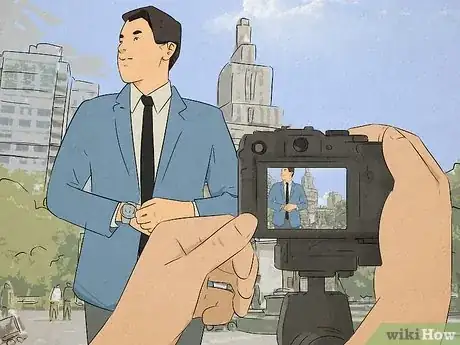


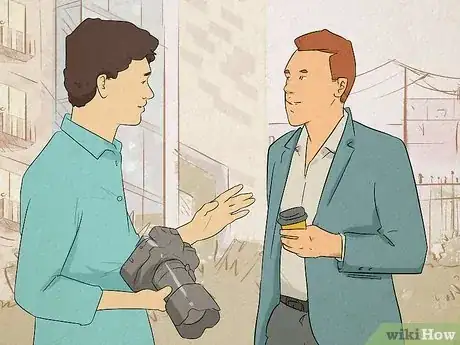



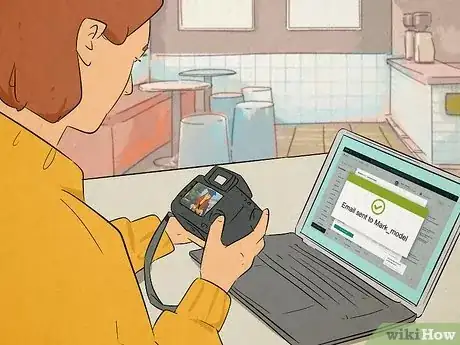


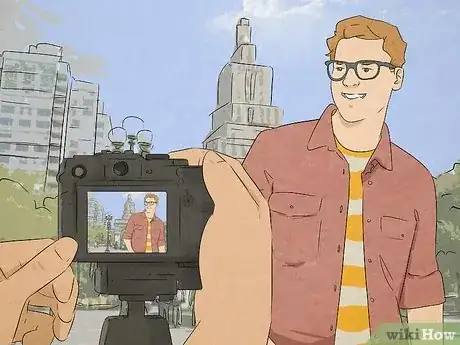
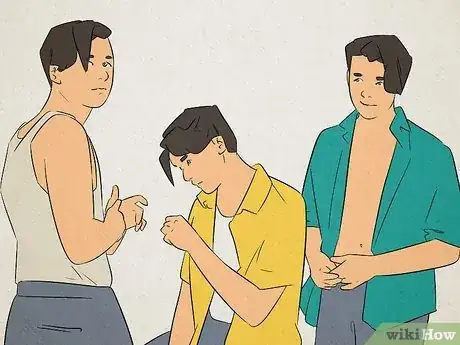
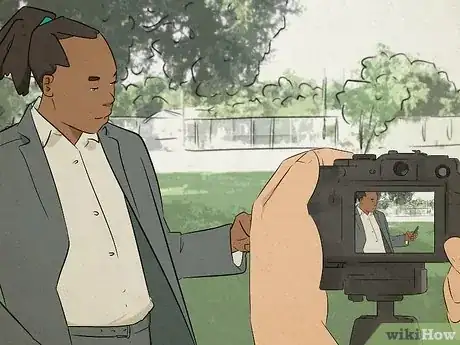
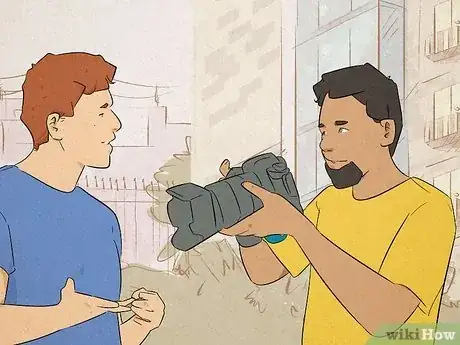



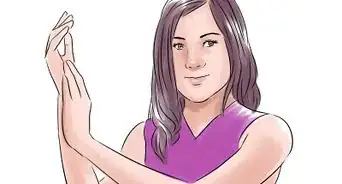

-Step-17-Version-3.webp)





















